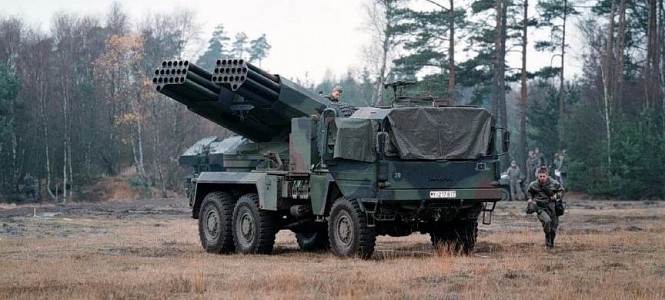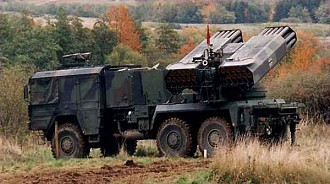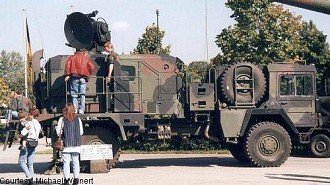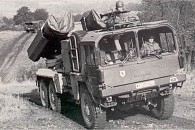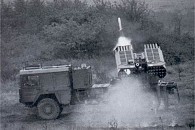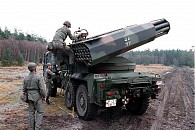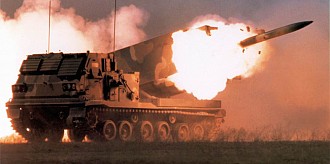Artillery / Multiple rocket launchers / LARS
LARS
General Facts
- TYPE
Multiple rocket launcher - ORIGIN
 Germany
Germany - NICKNAMES
LARS / Leichtes Artillerieraketensystem, light artillery rocket system (full name) - DESIGNED
1960's - DESIGNER
Weggman & Co. - PRODUCTION
1969 - 1971 (about 200 LARS 1)
1980 - mid 1980's (LARS 2 conversions)
1981 - 1983 (50 FERA) - PRODUCERS
 Germany - Wegmann
Germany - Wegmann - QUANTITY
About 200 LARS 1 produced
50 FERA produced - UNIT COST
Unknown - CHARACTERISTICS
 Several types of ammunition available
Several types of ammunition available
 Good accuracy with fire control radar
Good accuracy with fire control radar
 Low cost and reliable system
Low cost and reliable system
 Limited range
Limited range
 Manual reload takes long
Manual reload takes long
Introduction
The LARS is a late Cold War era multiple rocket launcher of German origin. It was developed in the 1960's to complement tube artillery. Conceptually the LARS is similar to the widely used Soviet BM-21 Grad. No LARS sytems remain in use today.
Layout
The LARS essentially is a truck based trainable launcher for unguided artillery rockets. The 110mm diameter artillery rockets are spin stabilized and use solid rocket fuel. Reloading is done manually by the three man crew. A firing unit consists of four launchers plus ammunition trucks. Originally the system was based on the Magirus-Deutz Jupiter 7t 6x6 truck, but was rebuilt in the 1980's on the more mobile MAN Kat 1 6x6 truck.
Firepower
The LARS has 36 launch tubes for 110mm artillery rockets. All tubes can be fired in 18 seconds. The minimum range is 6.5 km and the maximum range is 14.7 km. Three types of ammunition are available: fragmentation, anti-tank mines and smoke. For self-defense a 7.62mm MG3 machine gun is fitted on a ring mount on the cabin roof.
Mobility
The original LARS uses the Magirus-Deutz chassis has a maximum road speed of 73 km/h. The LARS 2 with MAN chassis has a maximum road speed of 90 km/h and an improved cross country performance.
Protection
The armored cabin of the LARS 1 provides limited protection against small arms fire and shrapnell. The LARS 2 is a softskin vehicle. No NBC systems are fitted. The somewhat limited range of the LARS makes it vulnerable to counter battery fire.
Users
The LARS was acquired only by Germany and was used by the German army. In the 1980's the LARS was improved as the LARS 2 by converting existing vehicles to a MAN 7t 6x6 truck chassis and by adding an artillery radar to each four vehicle unit. Since the mid 1990's the LARS was supplemented in German service by the American M270 MLRS system, known in Germany as MARS. Last units were replaced in the year 2000, ending the service life of the LARS.
LARS 1
LARS 1: The LARS 1 is the original production model of the LARS. It is based on the Magirus-Deutz Jupiter 178D15A 7 ton 6x6 truck chassis. A firing unit exists of four LARS 1 plus several transport trucks carrying additional ammunition. The LARS 1 is easily identified by its two banks of 18 launch tubes in conjunction with the bonnet truck chassis.
- Specifications:
- LARS 1
| Type | Multiple rocket launcher |
|---|---|
| Crew | 3 (commander, driver, gunner) |
| Length | 7.66 m (travel configuration) |
| Width | ? |
| Height | 2.82 m (travel configuration) |
| Ground clearance | ? |
| Weight | 15 t combat load |
| Ground pressure | ? |
| Wheelbase | Wheeled chassis, 6x6 |
| Turn radius | ? |
| Engine | ? |
| Power ratio | ? |
|---|---|
| Transmission | ? |
| Speed | 73 km/h on road |
| Fuel | ? |
| Range | 500 km |
| Wall | ? |
| Trench | ? |
| Gradient | ? |
| Fording | ? |
| Armor | Steel armor on crew cabin |
| NBC equipment | No |
| Night vision | No |
|---|---|
| Smoke | No |
| Remarks | - |
| Armament | 110mm artillery rocket (36x) 7.62mm MG3 roof machine gun |
| Weapon1 | 110mm LARS rocket launcher 36 launch tubes, no additional ammunition powered elevation and traverse non-stabilized |
| Weapon2 | 7.62mm MG3 machine gun on vehicle roof 100 rounds ready to fire manual traverse and elevation non-stabilized |
| Weapon3 | - |
| Weapon4 | - |
| Weapon5 | - |
| Weapon6 | - |
LARS 2
LARS 2: The LARS 2 is a product-improved version of the LARS 1. No new LARS 2 were produced, all have been converted from LARS 1. The LARS 2 replaces the Magirus-Deutz Jupiter chassis with a newer MAN Kat 4520 7 ton 6x6 truck chassis. Additionally a fire-control radar unit, known as FERA, was added to each four vehicle firing unit.
- Specifications:
- LARS 2
| Type | Multiple rocket launcher |
|---|---|
| Crew | 3 (commander, driver, gunner) |
| Length | 8.28 m (travel configuration) |
| Width | 2.50 m |
| Height | 2.99 m (travel configuration) |
| Ground clearance | ? |
| Weight | 17.5 t combat load |
| Ground pressure | ? |
| Wheelbase | Wheeled chassis, 6x6 |
| Turn radius | 19.5 m |
| Engine | ? |
| Power ratio | ? |
|---|---|
| Transmission | ? |
| Speed | 90 km/h on road, 20 km/h offroad |
| Fuel | ? |
| Range | 550 km |
| Wall | ? |
| Trench | ? |
| Gradient | ? |
| Fording | ? |
| Armor | No |
| NBC equipment | No |
| Night vision | No |
|---|---|
| Smoke | No |
| Remarks | - |
| Armament | 110mm artillery rocket (36x) 7.62mm MG3 roof machine gun |
| Weapon1 | 110mm LARS rocket launcher 36 launch tubes, no additional ammunition powered elevation and traverse non-stabilized |
| Weapon2 | 7.62mm MG3 machine gun on vehicle roof 100 rounds ready to fire manual traverse and elevation non-stabilized |
| Weapon3 | - |
| Weapon4 | - |
| Weapon5 | - |
| Weapon6 | - |

